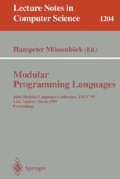Abstract
Multitasking is a topic on which many discussions have been held. There are different opinions about its need. Our own operating system, Oberon, was originally designed as a single user and single process system. While developing server systems and simulation kits we came to the conclusion that we need some notion of slim and easy to use process. We then decided to start a new project comprising the design of a new kernel and a new compiler for the support of concurrent execution of several processes on different priority levels with an appropriate protection mechanism preventing processes from inadmissible access to each other. The idea of active objects, simultaneously representing processes and containing both their action and their data, was the base for the ‘Active-Oberon’ project. Active objects are independent processes scheduled by the system. The management of the memory including stack allocation devolves on the new kernel. This takes much responsibility away from the programmer and makes the system safer.
The goal of this paper is to present the implementation of the ‘Active-Oberon’ project whose concepts are described in detail in [Gut96b].
Preview
Unable to display preview. Download preview PDF.
References
Jean Bacon; Concurrent Systems; An Integrated Approach to Operating Systems, Database, and Distributed Systems; Addison Wesley; 1993
Régis Crelier; OP2: A Portable Oberon-2 Compiler; Proceedings of the 2nd International Modula—2 Conference, Loughborough, England, 58–67; 1991
Reinhard A. Dietrich; Dynamic Stacks for Lightweight Processses; Diplomarbeit ETHZ; 1994
Jürg Gutknecht; Oberon, Gadgets and Some Archetypal Aspects of Persistent Objects, Information Sciences: An International Journal, 1996
Jürg Gutknecht; Do the fish really need remote control? Proceedings of the JMLC, Linz, Austria; 1997
Jürg Gutknecht; Vorlesung: Simulation diskreter Systeme; ETH Zürich
C.A. R. Hoare; Monitors: An Operating System Structuring Concept; Communication of the ACM 18(2), 1975
Intel Corporation; 386 DX Microprocesssor Programmer's Reference Manual; 1991
Refer to ftp://anonymous@ftp.inf.ethz.ch/pub/Oberon/System3/Native
M. Reiser; The Oberon System: User Guide and Programmer's Manual; Addison-Wesley, 1991
NiklausWirth, Jürg Gutknecht; The Design of an Operating System and Compiler; ACM Press; 1992
Niklaus Wirth; The Programming Language Oberon; Software — Practice and Experience 18(7): 671–690, July 1988
Author information
Authors and Affiliations
Editor information
Rights and permissions
Copyright information
© 1997 Springer-Verlag Berlin Heidelberg
About this paper
Cite this paper
Disteli, A.R., Reali, P. (1997). Combining Oberon with active objects. In: Mössenböck, H. (eds) Modular Programming Languages. JMLC 1997. Lecture Notes in Computer Science, vol 1204. Springer, Berlin, Heidelberg. https://doi.org/10.1007/3-540-62599-2_42
Download citation
DOI: https://doi.org/10.1007/3-540-62599-2_42
Published:
Publisher Name: Springer, Berlin, Heidelberg
Print ISBN: 978-3-540-62599-5
Online ISBN: 978-3-540-68328-5
eBook Packages: Springer Book Archive

